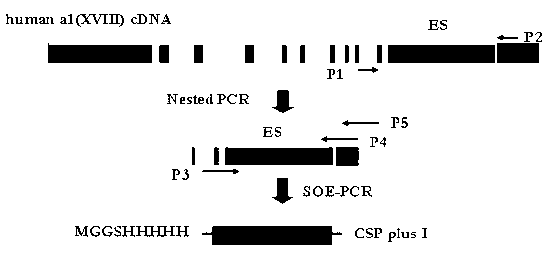Hepatic targeting peptide and angiogenesis inhibitor fusion protein as well as preparation method and application thereof
An angiogenesis inhibition and fusion protein technology, which is applied in the field of medicine and biology, can solve the problems of increasing drug costs, adverse effects of angiogenesis, and side effects, and achieve the effects of reducing systemic dosage, improving specificity, and treating liver cancer
- Summary
- Abstract
- Description
- Claims
- Application Information
AI Technical Summary
Problems solved by technology
Method used
Image
Examples
Embodiment 1
[0036] Example 1 Preparation of Fusion Protein of Liver Targeting Peptide and Endostatin
[0037] For the construction process of liver-targeting peptide and ES fusion gene, see figure 1
[0038] S1. Cloning of the ES gene
[0039] Cell culture and total RNA extraction: Embryonic liver cells L-02 were cultured in 1640 cell culture medium containing double antibodies (100U / ml penicillin, 100ug / ml streptomycin) and 10% fetal bovine serum until the cells were confluent. TIANGEN TRNzol Total RNA Extraction Kit Instructions Operation, every 10cm 2 Add 1ml TRNzol to the area to extract total cellular RNA.
[0040] Detection of RNA: Take 2 μL of RNA sample, add sample buffer, and electrophoresis on 1.0% agarose gel at 80V for 20 min. EB staining, gel imager to detect RNA integrity; use RNase-free ultrapure water to dilute the total RNA product at 1:50, read with a nucleic acid and protein analyzer, and analyze the concentration and purity of the RNA sample. 1.8≤OD 260 / OD ...
Embodiment 2
[0076] Example 2 Preparation of Liver Targeting Peptide and Angiostatin Fusion Protein (AS-CSP)
[0077] Design primers, use the SOE-PCR method to add the CSP I-plus gene sequence at the amino or carboxyl end of the angiostatin gene; when the amino end is added, the amino acid sequence of the fusion protein is shown in SEQ ID NO: 2, and its corresponding nucleotide The sequence is shown in SEQ ID NO: 13; the amino acid sequence of the fusion protein when the carboxyl terminal is added is shown in SEQ ID NO: 3, and the corresponding nucleotide sequence is shown in SEQ ID NO: 14. The linked fusion protein gene was eukaryotically expressed and purified to obtain the fusion protein. The specific method was the same as in Example 1.
Embodiment 3
[0078] Example 3 Preparation of fusion protein of liver targeting peptide and human plasminogen kringles5
[0079] Primers were designed, and the CSP I-plus gene sequence was added to the amino or carboxyl terminus of the human plasminogen kringles5 gene using the SOE-PCR method; when the amino terminus was added, the amino acid sequence of the fusion protein was shown in SEQ ID NO: 4, and its corresponding The nucleotide sequence is shown in SEQ ID NO: 15; the amino acid sequence of the fusion protein when the carboxyl terminal is added is shown in SEQ ID NO: 5, and the corresponding nucleotide sequence is shown in SEQ ID NO: 16. The linked fusion protein gene was eukaryotically expressed and purified to obtain the fusion protein. The specific method was the same as in Example 1.
PUM
| Property | Measurement | Unit |
|---|---|---|
| Molecular weight | aaaaa | aaaaa |
Abstract
Description
Claims
Application Information
 Login to View More
Login to View More - R&D Engineer
- R&D Manager
- IP Professional
- Industry Leading Data Capabilities
- Powerful AI technology
- Patent DNA Extraction
Browse by: Latest US Patents, China's latest patents, Technical Efficacy Thesaurus, Application Domain, Technology Topic, Popular Technical Reports.
© 2024 PatSnap. All rights reserved.Legal|Privacy policy|Modern Slavery Act Transparency Statement|Sitemap|About US| Contact US: help@patsnap.com










